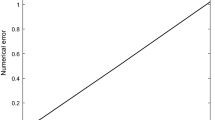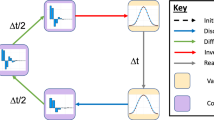Abstract
A mathematical model of the pharmacokinetics of anticancer drugs, which presents a biological tissue as a randomly inhomogeneous medium, is proposed. The model is based on a system of reaction-diffusion equations in which the coefficients are random functions of space and time. The coefficients of the model are calculated based on the probability of processes occurring in living tissue. Examples of the application of the proposed approach on two drugs are shown: cisplatin, which is used in cancer chemotherapy, and boron-phenylalanine, which is proposed as an agent (drug) that increases the dose during irradiation. The model demonstrates good agreement with the experimental results. The described method for modeling the pharmacokinetics of drugs can serve as a universal approach for modeling the spatiotemporal distribution of many drugs, including those using nanoparticles. The simulation results allow us to propose the optimization of the existing protocols for chemotherapeutic and radiological treatment.





Similar content being viewed by others
REFERENCES
W. S. Kiger, M. R. Palmer, K. J. Riley, R. G. Zamenhof, and P. M. Busse, “Pharamacokinetic modeling for boronophenylalanine-fructose mediated neutron capture therapy: 10B concentration predictions and dosimetric consequences,” J. Neuro-Oncol. 62, 171–186 (2003). https://doi.org/10.1023/A:1023297107525
M. J. Kim, R. J. Gillies, and K. A. Rejniak, “Current advances in mathematical modeling of anti-cancer drug penetration into tumor tissues,” Front. Oncol. 3, 278, 1–10 (2013). https://doi.org/10.3389/fonc.2013.00278
K. Ulbrich, K. Holá, V. Šubr, A. Bakandritsos, J. Tuček, and R. Zbořil, “Targeted drug delivery with polymers and magnetic nanoparticles: Covalent and noncovalent approaches, release control, and clinical studies,” Chem. Rev. 116 (9), 5338–5431 (2016). https://doi.org/10.1021/acs.chemrev.5b00589
E. Syková and C. Nicholson, “Diffusion in brain extracellular space,” Physiol. Rev. 88 (4), 1277–1340 (2008). https://doi.org/10.1152/physrev.00027.2007
J. Schuemann, A. F. Bagley, R. Berbeco, K. Bromma, et al., “Roadmap for metal nanoparticles in radiation therapy: current status, translational challenges, and future directions,” Phys. Med. Biol. 65 (21), 21RM02 (2020). https://doi.org/10.1088/1361-6560/ab9159
F. Moukalled, L. Mangani, and M. Darwish, The Finite Volume Method in Computational Fluid Dynamics. An Advanced Introduction with OpenFOAM® and Matlab, Fluid Mechanics and Its Applications, vol. 113 (Springer, Cham, 2016). https://doi.org/10.1007/978-3-319-16874-6.
Y. Saad, Iterative Methods for Sparse Linear Systems, 2nd ed. (SIAM, Philadelphia, PA, 2003). https://doi.org/10.1137/1.9780898718003.
H. Fukuda, C. Honda, N. Wadabayashi, T. Kobayashi, K. Yoshino, J. Hiratsuka, J. Takahashi, T. Akaizawa, Y. Abe, M. Ichihashi, and Y. Mishima, “Pharmacokinetics of 10B-p-boronophenylalanine in tumours, skin and blood of melanoma patients: A study of boron neutron capture therapy for malignant melanoma,” Melanoma Res. 9 (1), 75–84 (1999). https://doi.org/10.1097/00008390-199902000-00010
H. Fukuda and J. Hiratsuka, “Pharmacokinetics of 10B-p-boronophenylalanine (BPA) in the blood and tumors in human patients: A critical review with special reference to tumor-to-blood (T/B) ratios using resected tumor samples,” Appl. Radiat. Isot. 166, 109308 (2020). https://doi.org/10.1016/j.apradiso.2020.109308
K. A. Tacka, D. Szalda, A. K. Souid, J. Goodisman, and J. C. Dabrowiak, “Experimental and theoretical studies on the pharmacodynamics of cisplatin in Jurkat cells,” Chem. Res. Toxicol. 17 (11), 1434–1444 (2004). https://doi.org/10.1021/tx0498760
K. A. Tacka, J. C. Dabrowiak, J. Goodisman, H. S. Penefsky, and A. K. Souid, “Effects of cisplatin on mitochondrial function in Jurkat cells,” Chem. Res. Toxicol. 17 (8), 1102–1111 (2004). https://doi.org/10.1021/tx0499564
J. D. Holding, W. E. Lindup, D. A. Bowdler, M. Z. Siodlak, and P. M. Stell, “Disposition and tumour concentrations of platinum in hypoalbuminaemic patients after treatment with cisplatin for cancer of the head and neck,” Br. J. Clin. Pharmacol. 32 (2), 173–179 (1991). https://doi.org/10.1111/j.1365-2125.1991.tb03878.x
S. Xu, B. Z. Olenyuk, C. T. Okamoto, and S. F. Hamm-Alvarez, “Targeting receptor-mediated endocytotic pathways with nanoparticles: Rationale and advances,” Adv. Drug Delivery Rev. 65 (1), 121–138 (2013). https://doi.org/10.1016/j.addr.2012.09.041
D. Hymel and B. R. Peterson, “Synthetic cell surface receptors for delivery of therapeutics and probes,” Adv. Drug Delivery Rev. 64 (9), 797–810 (2012). https://doi.org/10.1016/j.addr.2012.02.007
H. Hillaireau and P. Couvreur, “Nanocarriers’ entry into the cell: Relevance to drug delivery,” Cell. Mol. Life Sci. 66 (17), 2873–2896 (2009). https://doi.org/10.1007/s00018-009-0053-z
Author information
Authors and Affiliations
Corresponding author
Ethics declarations
The authors declare that they have no conflicts of interest.
Rights and permissions
About this article
Cite this article
Ginevsky, A.F., Ginevsky, D.A. & Izhevsky, P.V. Numerical Modeling of the Spatiotemporal Distribution of a Drug Agent in a Biological Tissue. Math Models Comput Simul 14, 442–451 (2022). https://doi.org/10.1134/S207004822203005X
Received:
Revised:
Accepted:
Published:
Issue Date:
DOI: https://doi.org/10.1134/S207004822203005X




